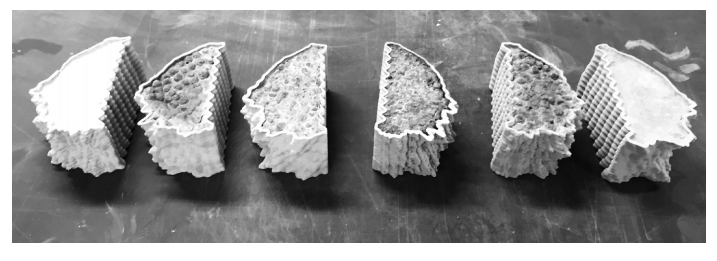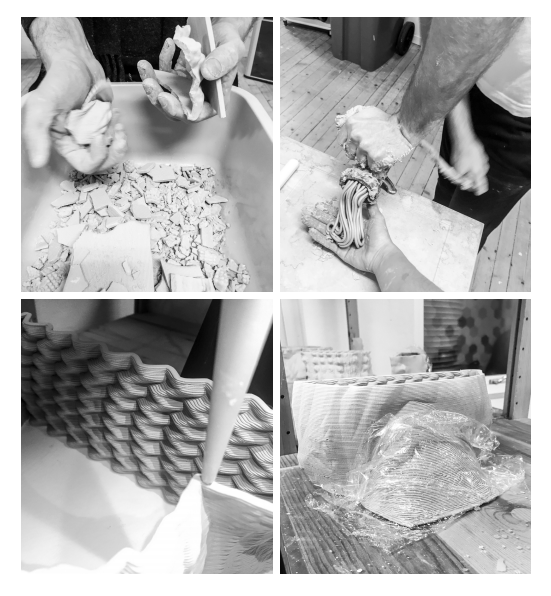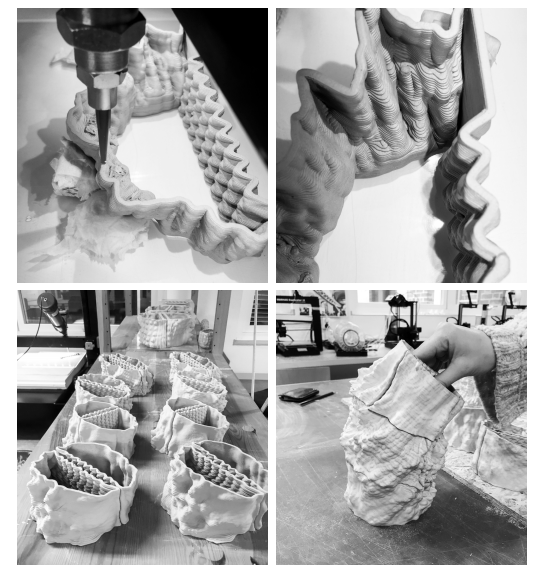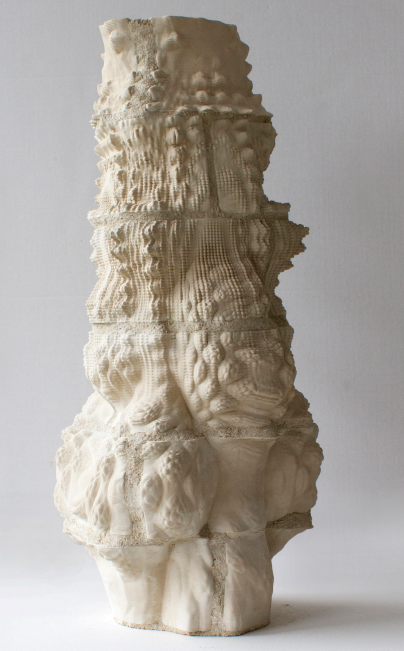In ‘The Weave – An Investigation into the Intersection of Craft and 3D-printing,’ Albin Karlsson and Johanna Jonsson of Sweden’s Lund University have written a master’s thesis centered around a new type of 3D printed ceramic brick and their unique desire to reconnect humanity with matter and the material world.
 While many contemporary 3D printing projects focus on creating a variety of small samples to be analyzed and tested, the product to be examined here is a brick urban shrine that the authors have named The Weave. The theme is not a religious one, but rather that of encouraging devotion to matter, and understanding how the Weave ‘relates to its urban context.’
While many contemporary 3D printing projects focus on creating a variety of small samples to be analyzed and tested, the product to be examined here is a brick urban shrine that the authors have named The Weave. The theme is not a religious one, but rather that of encouraging devotion to matter, and understanding how the Weave ‘relates to its urban context.’
“Going into The Luminous Ground, one of the most recent works of the architect and architectural theorist Christopher Alexander, we have looked into how the currently prevailing metaphysical view of matter has come to affect contemporary architecture in several regards, and what is perhaps needed in order to step out of the dogmatic approach to design (and the material world in general) to which it can be argued it has led us.
“By merging the digital with the physical, guided by Alexander’s philosophy, we are in this project exploring the potential to convey feelings of relatedness to the world in a structure constructed through the means of ceramic 3D-printing.”
As it is related to architecture, the authors take time to discuss disenchantment of the West, theorizing on some of the ‘inducing factors,’ along with metaphysics, worldview, and ultimately, defining what is center to their thesis: an alternative view of matter. Doing extensive research, Albin Karlsson and Johanna Jonsson traveled as far as India, studying Hindu temple architecture—exploring further into Hindu cosmology, philosophy, and how that affects their architecture. They were also able to view several temples in Ahmedabad for further architectural perspective.
During the experimental phase of their thesis study—along with exploring 3D fractal noise and ‘noise soup’—the authors studied materials required to make 3D printed composite bricks, manufacturing two columns, an arch, and a 1:2 prototype for part of the Weave.
“It became apparent that the minute movements of the extruder, derived from the high resolution of the computer model, simply did not succeed in being accurately represented by the relatively thick diameter of the string of clay being extruded. We also conducted a series of investigations into how different noise soups can be used to alter the shape of geometrical forms,” explained the authors.
Four noises were applied to create 3D printed geometries which they called Sinusoid, Periodic Perlin, Perlin, and Worley.
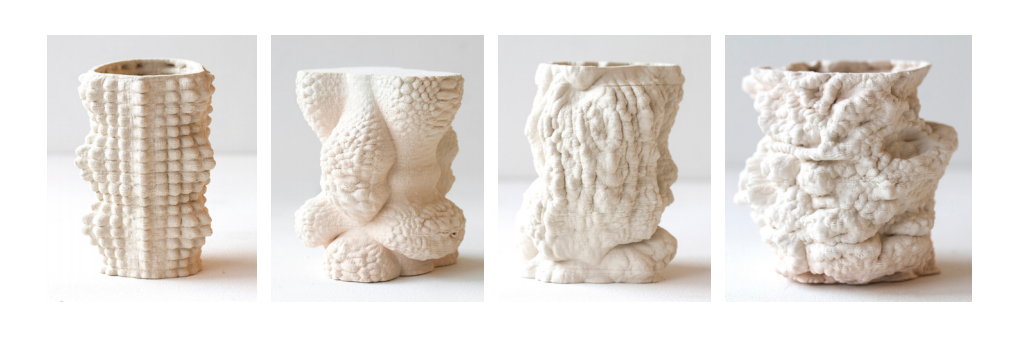
These are, from left to right, known as Sinusoid, Periodic Perlin, Perlin, and Worley. The difference between Perlin and Periodic Perlin is that the latter is repetitive in its manner and thus patterns are able to reappear in a geometry manipulated by a noise of this sort. Sinusoid is, by nature, also periodic.
As they moved ahead to 3D printing the columns, Karlsson and Jonsson were on a learning curve regarding 3D printing and working with new materials:
“In the crafting of the column, we discovered numerous things that helped us improve the fabrication process of the subsequent structures,” explained the authors. “Each layer of the first column was made up of four bricks. The bricks were fashioned in such a way so as to put them together would imply the column having a hollow core. However, because each of the inner sides of the bricks was flat, they did not really sit perfectly next to each other and gaps of varying distances were visible in the structure.
“Reviewing the column, we also discovered that some of this aforementioned unexactness of the bricks could possibly have to do with the clay and the fact that the proportion of clay to water was different when printing different bricks. Thus, some bricks would, as a result, shrink more during the drying process compared to others.”
Karlsson and Jonsson continued to evaluate a variety of creased surfaces. They decided on a variant resulting in wavy transformations traveling in three different directions. For the second column, they also decided to make each layer with just two bricks—but they were twice as large.
“To have fewer but bigger bricks increase efficiency when 3D printing as one does not have to start anew quite as often,” they said.
There were some issues with deformation as they continued to print, but Karlsson and Jonsson attributed such challenges to ‘bold overhangs created by the noise.’ Both the arch and weaves were printed with greater ease.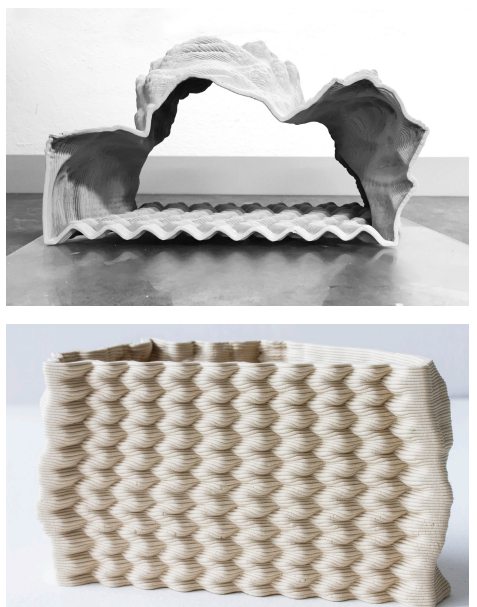
Several different surfaces were examined before they decided on all the necessary details for the bricks, created as follows:
- Clay was prepared using a meat grinder.
- Each brick was 3D printed, taking anywhere from 15 minutes to 2 hours.
- Bricks were dried evenly.
- Bricks were fired and, in some cases, glazed, then filled, then assembled.
The authors note that they did not ever expect to create a true architectural structure, but they did tackle the challenge of filling the bricks, experimenting with a mix of cement and other materials such as vermiculite, perlite, and leca balls. They added extra granulates at the top of the structure, and less as they descended.
Work on the second column proceeded more easily but they did realize that most of what came later was a complete learning experience.
For creating the arch, the researchers again were continuing to use their increasing sense of knowledge bout 3D printing, materials, glazing, and assembly. They had to re-do some of the work several times until they got it right.
“The form-finding of a structure was thus sometimes colored by us trying to hold back the intricacy and intriguing formal expressions to avoid creating something too alien that might be hard to relate to,” concluded the authors. “However, to create something too ordinary could also potentially be a problem. Hence the digital processes can be compared to a balancing act between the ordinary and the alien.
“Moreover, what we noticed was that the 3D-printed PLA versions of the structures had a tendency of feeling more alien than the fully assembled structures made of 3D-printed ceramic bricks. Somehow, when the structures were brought into a much larger architectural scale and needed to be assembled with mortar and handicraft as a result became more pronounced, ties were tied to our physical reality, and as a consequence the structures felt less alien and managed to relate more to us as humans, which was the main goal of the structures all along – to somehow formalize and help to bring forth the much-needed reconnection between humans and matter and the material world.”
While 3D printing has accompanied many artists, designers, engineers, architects and a host of other users in extremely valuable learning—and sometimes similar intellectual—experiences, the use of innovative construction materials continues to fascinate many, whether with the use of brick in other architectural installations, cement frameworks, creating new foamed concrete panels, or even looking forward to self-repairing materials.
What do you think of this news? Let us know your thoughts! Join the discussion of this and other 3D printing topics at 3DPrintBoard.com.
[Source / Images: ‘The Weave – An Investigation into the Intersection of Craft and 3D-printing’]Subscribe to Our Email Newsletter
Stay up-to-date on all the latest news from the 3D printing industry and receive information and offers from third party vendors.
Print Services
Upload your 3D Models and get them printed quickly and efficiently.
You May Also Like
Consolidation in AM: How 2025 Is Shaping the Industry’s New Normal
The first half of 2025 has been marked by a clear shift in the additive manufacturing (AM) industry. Companies are no longer just focused on developing new tech by themselves....
Etsy Design Rule Change Reduces Selection of 3D Printed Goods
Online marketplace Etsy has implemented a rule change requiring all 3D printed goods on the site to be original designs. The update to the site’s Creativity Standards states, ¨Items produced using...
U.S. Congress Calls Out 3D Printing in Proposal for Commercial Reserve Manufacturing Network
Last week, the U.S. House of Representatives’ Appropriations Committee moved the FY 2026 defense bill forward to the House floor. Included in the legislation is a $131 million proposal for...
Transforming From Tourist to Native: Duro CEO Michael Corr Explains Why the Company Rebuilt its PLM Software on AI
In these early innings of the AI boom, many market analysts have expressed concern that AI spend has gotten too far ahead of the technology’s proven ability to deliver significant...


